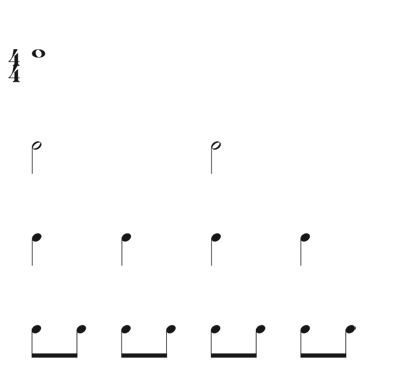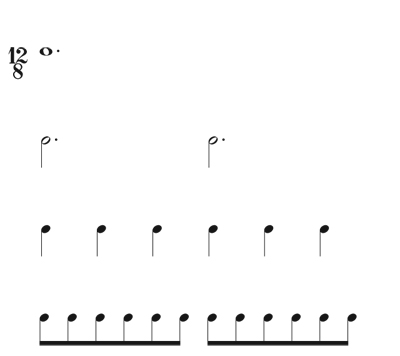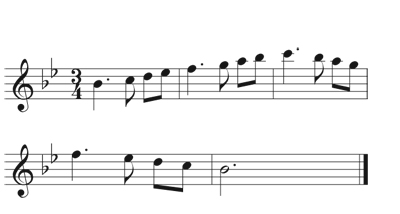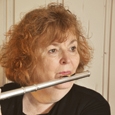As teachers we listen to students, offer suggestions, listen again, and offer more suggestions. However, one of the most difficult aspects of teaching is discovering what the student does not know. Once you have located the holes in a student’s thinking or understanding, then you will know how to proceed.
One well-known all-state clinician commented that students can play their instruments better than ever, yet have the same rhythmic problems that plagued earlier generations. He continued, “If I ask any student to explain what 68 means, I won’t get a clear answer. Unfortunately students play 6/8 by ear.” I agree. Rhythm is certainly an area that challenges the student, the amateur, and the professional.
To discover where the holes are in a student’s understanding and performance skills relating to rhythm, I have assembled a list of questions to ask students. After each question, an answer is provided along with a discussion of various ways to teach the concept if students have problems in this area. These questions are followed by three examples for students to sightread without any coaching from the teacher.
How would you define simple meter and compound meter?
Answer: Simple meter is when the individual beat is divisible by 2’s as in 2/4, 3/4 and 4/4 meter. Compound meter is when the individual beat is divisible by 3 as in 3/8, 6/8, 9/8, and 12/8.
Teaching Idea: On land or by sea?
A good way to explain the difference between simple and compound meter is to ask, “Is it on land or by sea?” Our bodies work on the principal of two’s. When we walk on land, we alternate the feet – left, right, left, right. The eyes open and close and we breathe in and we breathe out. We are in two.
Yet when we ride in a boat on the sea, the boat does not float up and down in two, but floats down, up, up in three. Jacques Offenbach certainly got it correct when writing his famous Barcarolle from The Tales of Hoffmann which is written in 6/8, a compound meter that is based on threes. Asking the question “Is it by land or by sea?” helps most students understand the practical difference between simple and compound meter.
What is the time signature?
Answer: The time signature, which indicates meter, is located at the beginning of a piece. There are two numbers, one above the other. The top number indicates how many beats there are in each measure. The lower number indicates what kind of note or unit of measurement represents one pulse or beat. Choices for the lower number might be: 2 = half note, 4 = quarter note, 8 = eighth note, 16 = sixteenth note, etc.
Teaching Idea: Rather than quizzing students on common time signatures start by asking about some they have never seen before (or may never see) such as 57 over 1or 22 over 64. The 57 over 1 indicates 57 beats in a measure, and each beat is represented by a whole note. So, each measure contains 57 whole notes. Working with the unusual helps students remember the order of the thought process in dealing with the time signatures in common usage such as 4/4 and 6/8.
As a performer, how do you show the meter?
Answer: Generally, meter is shown through inflection following the strength of the beat rule. In 2/4 meter, the first beat is played strongly, and the second beat weaker. In 3/4 meter, the first beat is strong, the second note less strong, and the third beat is the least strong. In 4/4 meter, the first beat is strong, the third beat is weak, the second beat is weaker, and the fourth beat is weakest. The same relationship occurs in compound meter.
What is the most obvious difference between the two notation trees shown below?
Answer: The compound notation tree employs the use of the dot. A dot after a note increases the value of the note by one-half.
A notation tree for simple time.

A notation tree for compound time.

Three Rhythmic Examples
Have students sightread each of the following examples without any coaching from you.
moderato
.jpg)
Time in music is designated by a tempo marking, a time signature, and the rhythm of the individual beat or pulse. In this example, the tempo marking is moderato, so the three measures should be played at a moderate speed. The time signature is 3/4 indicating there are three beats in each measure with the quarter-note receiving one beat or pulse. Many novice and not so novice musicians have trouble playing the first dotted-quarter note accurately. Even though the student knows the dot after the quarter lengthens the quarter by one-half value or an eighth note, when counting aloud the student has little idea of where the + after 2 occurs. Rather than counting 1 + 2+ 3+, try having a student count “1 + DOT + 3 +.” This shows the student exactly where the dot occurs and its length. Since most middle and high school bands play very little music in 3/4 meter, practice nine-note scales in this rhythm to learn to play dotted quarter-notes accurately. Experienced teachers often call the dotted quarter-note a three-eighths note to highlight its true value.
Nine-note scale

Rhythm applied to nine-note scale

When working on this exercise, introduce additional activities as well. For example, if a student is sitting down while playing the example, have him lift his right leg on the + of 2 or on all the first beats. Repeat lifting the left leg. Alternatively have students clap rhythms on their legs or laps as they count aloud. This combines aural and tactile sensations and helps students learn the concept more thoroughly.
This tempo marking of this exercise is Vivo. The 6/8 time signature indicates six beats in each measure and the unit of measurement is an eighth-note. Since the tempo marking Vivo is played quickly, the six beats in each measure are played in two groups of three eighth-notes. This is sometimes referred to as playing fast 6/8. The strong beats are the first and fourth eight-notes. Notice the second note, a C4, is a weak note in the previous rhythmic example in 3/4 and a strong note in this one.

The tempo marking of this exercise is Largo. The 6/8 time signature indicates there are six beats in each measure and the unit of measurement is an eighth-note. Since the tempo marking Largo is played very slowly, each of the six beats in the measure receive one pulse. This is sometimes referred to as playing slow 6/8.The strong beats are still the first and the fourth eighth-notes.

What is the difference between these last two examples?
Answer: The difference between these two examples has to do with the tempo indication. The time signature and the note pitches and rhythm are exactly the same, yet one is played in two and the other in six.
Drill
Novice teachers are often afraid of having the students drill a concept day after day. Seasoned teachers know that students should drill concepts daily. Never be afraid of teaching the simple and the obvious. While it may be obvious to you, it may not be to students. Each week select a rhythm of the week, and alternate between simple and compound meters. Practice this rhythm on unison notes, scales, arpeggios, seventh chords etc. Not only will you be developing theoretical knowledge, but you will be enhancing the rhythmic performance of your students when they are playing their solo and band repertoire.






